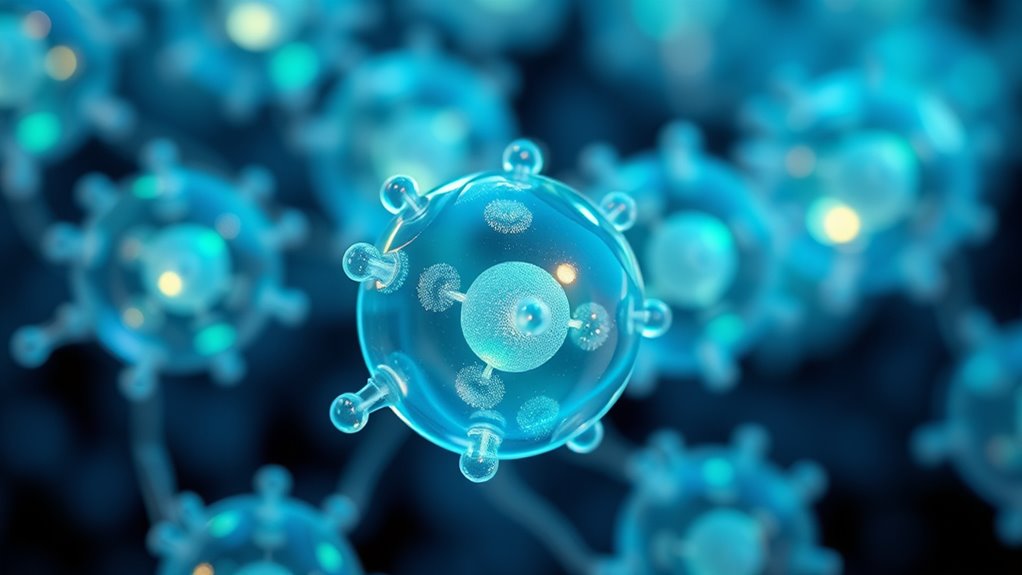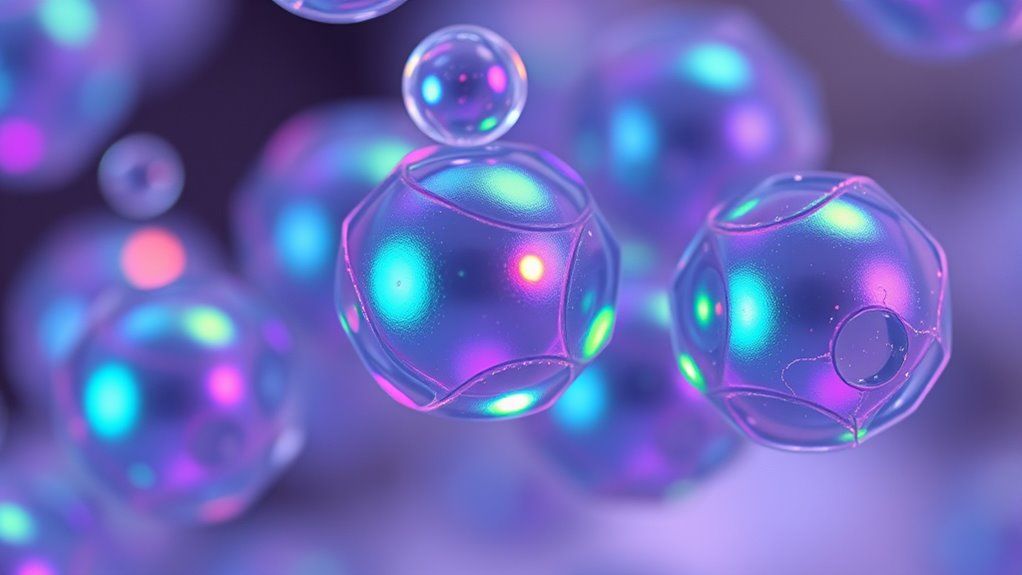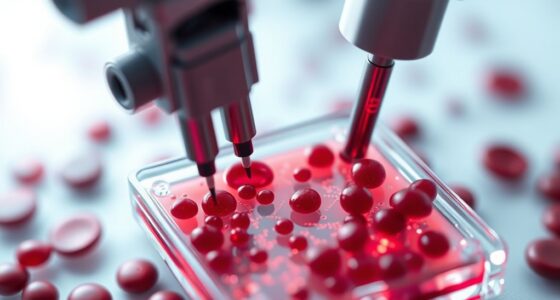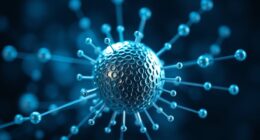Stimuli-responsive nanocarriers are designed to release drugs precisely when triggered by body signals like pH changes, temperature shifts, enzymes, or magnetic fields. These smart carriers respond by breaking bonds, swelling, or degrading in targeted environments such as tumors or infection sites. Material choices and surface modifications help improve stability, targeting, and safety. To discover how these advanced systems work and their potential in medicine, explore further details below.
Key Takeaways
- Stimuli-responsive nanocarriers release drugs specifically in response to environmental triggers like pH, temperature, enzymes, or magnetic fields.
- They utilize mechanisms such as bond cleavage, polymer swelling, or matrix destabilization for controlled, site-specific drug delivery.
- Material design emphasizes biocompatibility, incorporating functional groups or linkages that respond to unique biological stimuli.
- These nanocarriers enhance targeted therapy, reducing side effects and increasing efficacy in diseases like cancer and infections.
- Challenges include ensuring stability, precise targeting, scalable manufacturing, and addressing long-term safety for clinical applications.
Types of Stimuli-Responsive Nanocarriers

Have you ever wondered how nanocarriers can respond to specific environmental cues? Different types of stimuli-responsive nanocarriers exist, each designed to react to particular triggers. pH-sensitive nanocarriers change their structure or release drugs when they encounter the acidic or basic environments within the body, such as tumor tissues or cellular compartments. Temperature-sensitive nanocarriers respond to local temperature variations, releasing their payload when heated slightly above normal body temperature. Enzyme-responsive nanocarriers are engineered to degrade or alter in the presence of specific enzymes found in target tissues. Magnetic nanocarriers react to external magnetic fields, allowing precise control over drug release and targeting. These various types enable tailored delivery systems, improving treatment efficacy while minimizing side effects. Incorporating advanced filtration technologies can further enhance the specificity and safety of these nanocarriers in medical applications.
Mechanisms of Stimuli-Triggered Release

Stimuli-responsive nanocarriers release their payloads through specific mechanisms triggered by environmental cues. When exposed to a stimulus, such as pH change, temperature shift, or enzyme presence, the nanocarrier’s structure undergoes a transformation. This can involve bond cleavage, polymer swelling, or destabilization of the carrier matrix. For example, in a low pH environment, acid-sensitive bonds break, releasing the drug. Temperature-sensitive carriers may expand or disassemble when heated. Enzyme-triggered release occurs when specific enzymes cleave linkages within the nanocarrier. These mechanisms guarantee controlled, site-specific delivery, minimizing off-target effects. The key is that the environmental cue directly induces a structural change, enabling payload release precisely where and when it’s needed. This targeted release enhances therapeutic efficacy and reduces side effects. Additionally, integrating advances like AI-powered processing can optimize the responsiveness and precision of nanocarrier systems.
Design Strategies and Material Considerations

Designing effective stimuli-responsive nanocarriers requires careful selection of materials that can reliably respond to specific environmental triggers. You should prioritize biocompatibility and stability to guarantee safe, predictable performance in biological systems. Polymers like poly(N-isopropylacrylamide) and poly(ethylene glycol) are popular choices due to their responsiveness and safety profiles. Incorporate functional groups or linkages that can cleave or change structure upon stimulus exposure, such as pH-sensitive bonds or disulfide bridges. Surface modifications, like PEGylation, can improve circulation time and reduce immune recognition. Material considerations also involve controlling size, shape, and surface charge to optimize targeting and release kinetics. Ultimately, your design must balance responsiveness, stability, and biocompatibility to develop effective, controlled-release nanocarriers. Additionally, understanding the science behind material interactions can help optimize the performance and safety of these systems.
Applications in Disease Treatment

How can stimuli-responsive nanocarriers revolutionize disease treatment? They enable targeted therapy, minimizing side effects and improving efficacy. These nanocarriers respond to specific disease-related stimuli, releasing drugs precisely where needed. Here are four key applications:
- Cancer therapy: Triggered by tumor microenvironment signals, they deliver chemotherapy directly to cancer cells.
- Infection control: Responding to bacterial enzymes or pH changes, they release antibiotics at infection sites.
- Gene delivery: Controlled release of genetic material enhances gene therapy accuracy and reduces off-target effects.
- Inflammatory diseases: Sensing inflammatory markers, they release anti-inflammatory agents precisely where inflammation occurs.
These capabilities make stimuli-responsive nanocarriers promising tools for more effective, personalized disease treatments. High precision in drug delivery is essential for maximizing therapeutic outcomes while minimizing adverse effects.
Future Perspectives and Challenges

Although stimuli-responsive nanocarriers hold great promise for personalized medicine, several challenges must be addressed before their widespread clinical adoption. You need to improve their stability in biological environments to prevent premature release and degradation. Achieving precise targeting remains difficult, as off-target effects can cause toxicity or reduced efficacy. Manufacturing consistency and scalability are also hurdles; complex synthesis processes hinder large-scale production. Additionally, understanding long-term safety and potential immune responses is essential. Regulatory frameworks need to evolve to evaluate these advanced systems effectively. You must also consider ethical issues surrounding nanotechnology. Overcoming these challenges requires interdisciplinary collaboration, innovative design, and rigorous testing. For example, active listening and empathy are crucial in designing patient-centric therapies that foster trust and adherence. Only then can stimuli-responsive nanocarriers realize their full potential in transforming disease treatment and personalized medicine.
Frequently Asked Questions
How Do Nanocarriers Target Specific Cell Types?
You can target specific cell types by designing nanocarriers with surface modifications like ligands, antibodies, or peptides that recognize and bind to unique markers on those cells. Once they find their target, the nanocarriers attach and release their cargo locally. This approach guarantees precise delivery, minimizes side effects, and improves treatment efficiency, making your therapy more effective and tailored to the specific cell type you’re aiming to treat.
What Are the Biocompatibility Concerns of Stimuli-Responsive Nanocarriers?
Think of stimuli-responsive nanocarriers as modern-day Pandora’s boxes. Their biocompatibility concerns include potential toxicity, immune reactions, and long-term accumulation in the body. You need to guarantee they don’t trigger adverse responses or damage healthy tissues. Careful material selection and thorough testing help mitigate these risks, so you can harness their benefits without releasing unforeseen health issues. Balancing innovation with safety is key to successful medical applications.
How Scalable Are Nanocarrier Production Methods?
You can scale up nanocarrier production using methods like microfluidics and high-pressure homogenization, which are adaptable for larger batches. These techniques allow precise control over size and uniformity, making industrial production feasible. However, challenges like maintaining quality, cost-effectiveness, and ensuring consistency across large batches remain. With ongoing advancements, you’ll find that scaling production is increasingly practical, especially as technology improves and regulatory standards evolve.
Can Stimuli-Responsive Nanocarriers Be Reused or Recycled?
Yes, stimuli-responsive nanocarriers can often be reused or recycled, but it depends on their design and application. You can typically recover them after delivery using techniques like centrifugation or filtration. Then, you may regenerate or modify them for subsequent use, reducing waste and costs. However, verify they retain their responsiveness and efficacy after recycling, as repeated use might affect their performance over time.
What Regulatory Hurdles Exist for Clinical Approval?
You face a formidable regulatory landscape when seeking clinical approval for stimuli-responsive nanocarriers. Agencies demand rigorous safety and efficacy data, extensive toxicity testing, and clear manufacturing standards. You must also navigate evolving guidelines specific to nanomaterials, which can delay progress. Ensuring consistent quality and demonstrating long-term stability are critical. So, while the path is complex, meticulous research and compliance can turn these innovative carriers into clinical realities.
Conclusion
By exploring stimuli-responsive nanocarriers, you open new possibilities for targeted, controlled drug delivery. These smart systems respond precisely to environmental cues, making treatments more effective and side effects fewer. As you navigate this evolving field, remember that innovation is the key to turning challenges into opportunities. Don’t put all your eggs in one basket—embrace diverse strategies and materials to stay ahead in this exciting journey toward personalized medicine.









